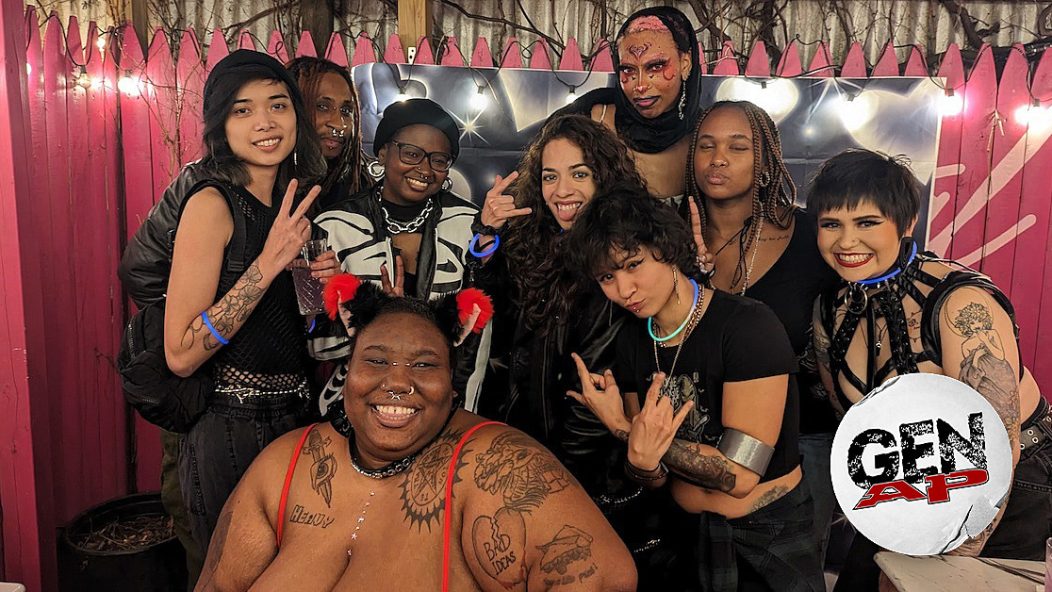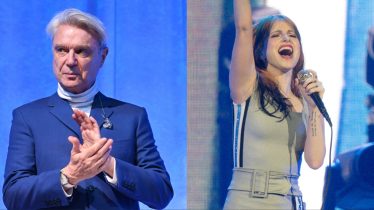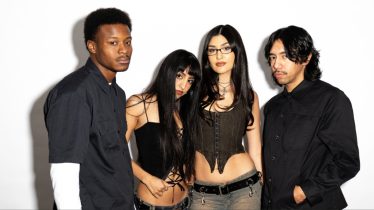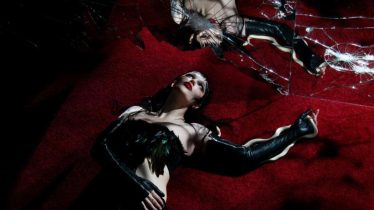
BIPOC Emo Night is giving Black and Brown emo fans a space of their own
Welcome to Generation AP, a weekly spotlight on emerging actors, writers and creatives who are on the verge of taking over.
In 2021 when Luna Becerra-Lewis went to an emo night in Las Vegas and saw a group wearing Make America Great Again hats, they instantly knew they wanted to create a space specifically for Black and Brown pop-punk fans — one where they could rock out without worry that they might be unwelcome in the scene.
After three months of planning, research, and dedication, BIPOC Emo Night was formed. And in just a little over one year, what began as a group of friends curating the spaces they yearned for in the alternative music scene has become a full-fledged collective, planning events and community meet-ups across the country.
“This music is political and I think there are a lot of people who grew up in the scene, but ignore the lyrics and the history of the music they listen to,” Becerra-Lewis says, noting artists like Bad Brains, Cinnamon Babe, and Fever 333 as examples of the spirit they want alternative spaces to embody.
Read more: Every Paramore album ranked
Motivated by this feeling, the 27-year-old took it upon themself in 2021 to figure out how to rent a venue in NYC so they could launch their own event where attendees could focus on the music, without the stress of feeling like they didn’t belong. They posted a call on Lex, a location-based app created to connect queer folks, and went on to host what would become the first BIPOC Emo Night event. 60 people came out on a cold December night to support the project, and based on its success, they were able to put together a small team to plan another Brooklyn-based event.
“We built BIPOC Emo Night to find community with marginalized people who share a common interest in alternative music, without dealing with any ‘isms, micro or macro aggressions, or the discomfort of being in a space that wasn’t created with you in mind,” Chantal A., a member of the BIPOC Emo Night collective, says.
Event by event, the collective grew, as attendees who believed in the group’s mission decided to get involved with planning events themselves. Even folks who’d heard about the group via social media started hosting pop-up events in different cities. Now, BIPOC Emo Night events have expanded outside of NYC to Los Angeles, San Francisco, and Boston — and the group has their sights set on hosting events outside of the U.S., too.
Chantal currently helps plan events on the west coast and was instrumental in planning the first BIPOC Emo night outside of NYC. She originally bonded with Becerra-Lewis over their shared love of late ‘00’s and early 2010s post-hardcore music, and the belief that no one should feel excluded from the alternative scene based on who they are. “Even today, I still find myself being one of few Black people in alt spaces and it can be difficult to just enjoy the music when you feel people staring at you, questioning your authenticity, and place in that space,” Chantal says. “In my humble opinion, nothing is more punk or alternative than being unambiguously and unapologetically Black, indigenous, queer, living with a disability, or having another marginalized identity, but we still have to fight for our right to just exist in the alt community.”
Becerra-Lewis manages an overall planning committee known as the collective, as well as individual sub-groups for organizers from individual cities across the U.S. — but because of how intentionally the collective works to integrate itself into each city’s already existing scene, no two cities’ emo nights are the same. NYC’s events are often bar takeovers with live solo artists and local drag artists, like Klondyke and Omen.Onyx. San Francisco’s event took the form of a house party, and Boston attendees were treated to an intimate show from local pop-punk band Yet To Bloom. Because these events are tailored by and for each local community, they provide a space where BIPOC locals can discover new art, uplift local performers, and make connections with likeminded people in their community.
“The [Yet To Bloom] show was on the smaller side, since it was the collective’s first one in the Boston area, but everyone was super supportive and the vibes were great,” says Yet To Bloom lead singer Claire Hudson, noting just how special the atmosphere felt. “We’re so happy to see this initiative reaching more people. The more, the merrier!”
Going forward, BIPOC Emo Night hopes to take their live shows a step further by connecting local artists from one city to fans in another. For a band like Yet To Bloom, for example, that might mean playing an emo night hosted by a collective outside of their hometown. Based on the reception to the Boston event, it seems likely that attendees in other cities would welcome live acts with open arms.
@bipocemonight We are #bipocemonight ! This is #byusforus 🖤 Follow us on IG or here to stay updated! #altpoc #emonight #pocemo #emonightsf #emonightbk #emonightla #emonightboston
As for the most recent Brooklyn BIPOC Emo Night, word-of-mouth brought Victoria Smith, a Ph.D. student studying ethnomusicology at the intersection of race and alternative music, to the Valentine’s Day-themed party. She attended the event because she’s always felt affirmed by alternative music and was excited to build community with folks who have similar interests and identities. She says, “This music is for everyone and it’s important that we have safe spaces where we can enjoy this music amongst ourselves.”
In Brooklyn, organizers from the planning team make a point to add music to the night’s mix from established Black and Brown alt artists that you might not hear at your typical emo night, in addition to local, up-and-coming Black and Brown artists. Becerra-Lewis mentions the collective members all contribute to the playlist and they love queueing up artists like Rico Nasty and Doechii, just as much as bands like Taking Back Sunday and My Chemical Romance — feeling as though the way those artists blend genres like rap and punk should be celebrated in alt spaces more than they often are.
Malachite Garrett, the NYC Outreach Coordinator for BIPOC Emo Night, also explains how important it is that they play local artists, too. They aim to have a positive impact on artists by connecting them with fans in their own area — which is something that talent like Zai, who performs as PixieShawty and appeared at the recent event, knows all too well. Garrett says, “[Zai] walked in and he’s like, ‘My song is playing over the speakers!’ and I’m like, ‘Of course! We did this for you.’”
Organizers for BIPOC Emo Night in NYC are also planning meet-ups at various rock shows in the city, including the upcoming tour dates for bands like Meet me @ the Altar, Magnolia Park, and Say Anything. This type of event format is a welcome addition to the emo nights, according to attendees like Smith. “The alt scene [here in NYC] is still very whitewashed,” Smith says. “Going to shows can be pretty overwhelming when you’re constantly one of a handful of melanated people in the audience. Whenever I go to a show, I immediately scan the room for other Black people, only to find a handful of us.”
Meet-ups outside of NYC should be coming soon, as well, as BIPOC Emo Night has already put out a call on social media for members to request cities and shows they might like to attend with a group. And beyond that, the collective is planning a tour where they’ll be hosting emo nights in Brooklyn, Minneapolis, and Washington, D.C. this spring. Between the upcoming slate of dates and the virtual events the collective has started hosting, sooner or later, no matter where you live, you should have a BIPOC Emo Night coming your way and making the scene feel more welcoming than ever soon.







